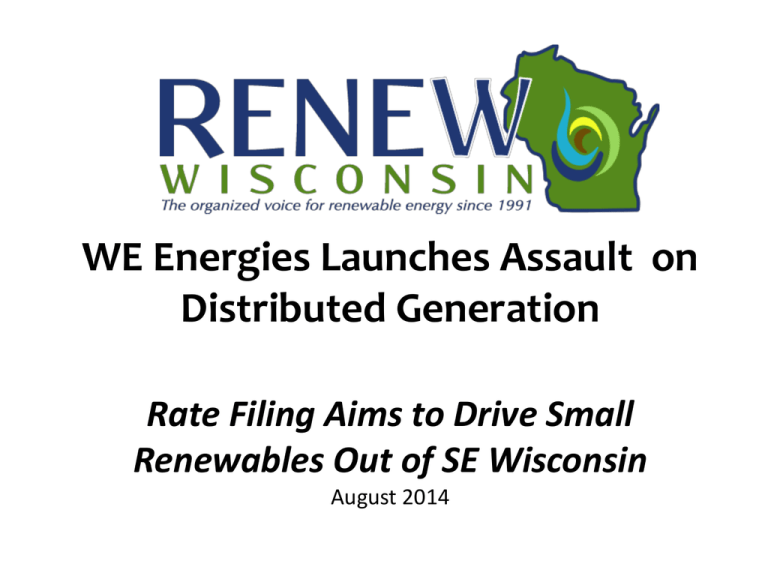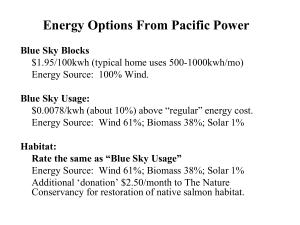From We Energies` filing
advertisement

WE Energies Launches Assault on Distributed Generation Rate Filing Aims to Drive Small Renewables Out of SE Wisconsin August 2014 In its current rate filing, We Energies unveils a punitive package of terms and conditions for owners of distributed generation, planned to take effect on January 2016. If approved by the Public Service Commission, these measures would throttle the distributed energy marketplace in WE territory and bring it to a standstill. These following slides document the rates, charges and penalties proposed by We Energies to squeeze small-scale electricity producers. Their aim is clear: to preserve its generation monopoly at all costs, even if it means denying customers the ability to self-generate with clean energy. Warning! This filing could be contagious Should the Public Service Commission approve WE’s harsh measures, you can be sure that other Wisconsin utilities will propose similar terms in their 2017-2018 filings. A Three-Pronged Assault on CustomerSited Renewables In a nutshell, WE proposes to: Impose hefty capacity charges on all net metered customers and stand-by charges on larger self-generators Change the terms of service to diminish returns on existing renewable energy investments by one-third Deny net metering service for leased and third-party owned solar systems New Terms of Service Beginning January 2016, all distributed generators (under 15 MW) interconnected to WE will be placed in one of four new categories of customer generation. 1. 2. 3. 4. COGS-NM (net metering) COGS-NP (non-purchase) COGS-DS (direct-sales) Cp-4/Cg-4 (stand-by service for large self-generators) Breaking Down COGS-NM 1. 2. 3. 4. 5. 6. Two-tiered rate structure (in place) Two meters w/ extra charge for second meter (new) Monthly netting instead if annual netting (new) Capacity demand charge (new) Capacity limit set at 300 kW (new) Customer must own system (new) COGS-NM Rates and Charges Revenue from Generation Offset Consumption Above Consumption Retail energy rate Avoided energy rate 13.9 cents/kWh ~4.2 cents/kWh Note: As of 1/1/2016, the net will be calculated each month New WE charges Capacity demand charge Facilities charge (2nd meter) $3.79/kW or $8.60/kW 2-10 cents/day Note: the lesser of the capacity demand charges would apply to solar and wind systems. All other customer generators would be subject to the higher charge, unless they are demand-metered. Case study of 4 kW solar system installed in 2013 Assumptions Annual household consumption is 6,000 kWh PV system produces 80% of household use (4,800 kWh) Current return –> 4,800 x 13.9 cents/kWh = $667/yr ($55.60/month) Economics of same system in 2016 Assumptions Of the 4,800 kWh produced each year, 400 kWh is credited at avoided cost rate (excess over consumption) Energy value – 4,400 x 13.9 cents + 400 x 4.2 cents = $628 or $52.33/month Capacity demand charge – 4kW x $3.79/kW = $15.96/month Facilities charge - $0.65 cents/month Result $52.33 - $15.96 – $0.65 = $36.72/month Quantifying the Hit to This PV System Owner Year Average monthly return 2014 2016 $55.60 $36.72 Difference ($) Difference (%) $18.88 34.3% How Radical Is this Proposal? Does any other WI utility impose (or plan to impose) demand-based penalties on customer generators? No Does any other WI utility require customer ownership of net metered systems? No Does We Energies Provide Any Numbers to Support the Need for Additional Charges and Penalties? No Comparing Net Metering Costs to We Energies Own Plants Generation Source Fuel source Size (in MW) 2013 Production Costs (cents/kWh) Elm Road* Coal 1275 14.76 Valley Coal 280 10.0 Port Washington Natural Gas 1150 7.3 Net metered Renewables Solar, Wind 4 13.9 Sources: We Energies 2014 Report to the PSCW, RENEW Note: In 2012, Elm Road’s all-in production costs were 22.3 cents/kWh Numbers That Matter Anticipated We Energies purchase price of Integrys Energy Group $9.1 billion Elm Road – Monthly and annual lease payments from We Energies customers to We Power (plant owner) $19.33 million $233 million We Energies CEO Gale Klappa’s compensation in 2012 $13 million Aggregate solar capacity interconnected to We Energies 7.5 megawatts Anticipated revenues in 2016 from demand penalties assessed on solar system owners $30,000/month $360,000/year *Subject to check: not yet confirmed Schools powered by renewable energy that will be hurt by these changes School MATC - Milwaukee Menomonie Falls North M.S. Lakeshore Technical College MATC – Oak Creek MATC – Ft. Atkinson Waukesha County Tech. College Kettle Moraine Lutheran H.S. Purdy Elementary – Ft. Atkinson Fort Atkinson H.S. Lake Country School Random Lake H.S. Lawrence University Fox Valley Lutheran H.S. Shorewood School District Lakeside Lutheran H.S. WI Lutheran College UW-Whitewater UW Milwaukee UW- Parkside HOPE Christian Schools WI Lutheran H.S. MKE Fairview School Concordia Univ. MKE Cooper School Faith communities powered by renewable energy that will be hurt by these changes House of Worship/County of Location Atonement Lutheran - Milwaukee St. Paul’s (Ixonia) Jefferson St. Paul’s Lutheran -Waukesha Church of the Resurrection - Waukesha Garden Homes Lutheran - Milwaukee Lake Country Unitarian - Waukesha Fox River Christian Church - Waukesha Good Shepherd Lutheran - Washington Risen Savior Lutheran - Waukesha Pilgrim United - Ozaukee Crown of Life Lutheran - Dodge First Congregational Church - Ozaukee St. Marcus Lutheran - Milwaukee Ascension Lutheran - Shawano Racine Dominicans EcoJustice Center - Racine Lake Park Lutheran Church - Milwaukee Bethlehem Evangelical Lutheran - Waukesha E&R United Church of Christ - Waukesha Morning Star Lutheran - Washington Cross Lutheran Church - Milwaukee Elm Grove Lutheran – Waukesha Local governments powered by renewable energy that will be hurt by these changes Local government City of Racine (City Hall) City of Whitewater Outagamie County (ATW) Town of Greenville (Outagamie) City of Milwaukee (Public Library) City of Wauwatosa (Fire Dept.) Town of Menasha (Winnebago) City of Brookfield (Safety Building) MMSD (Milwaukee) Businesses powered by renewable energy that will be harmed by these changes Business Johnson Controls JJ Keller Kohl’s Dept. Stores (3 stores) American Transmission Co. GE Health Care (3 locations) Full Circle Farm SCA Tissue Osborn Nursery Preder Farm Werner Electric Menasha Corp. WAGO Corporation Potawatomi Bingo Casino Bergstrom Mini Cedar Lake Rehabilitation UW Milwaukee What’s Different about COGS-NP? The trade-off here is: the non-purchase service would allow customer-generators to keep their existing meter and avoid the facilities charge. However, any generation that is exported to the grid is effectively donated to WE. Amazingly enough … Those who elect this service option would still be subject to the capacity demand charge, even though they receive no credit for exported electricity. Which Begs the Question … What is the difference between cutting one’s bill in half through conservation measures vs. self-generation whose costs and benefits are fully internalized within the customer? Put another way, why does self-generation warrant a capacity penalty but not conservation? How is this not discriminatory? What is COGS-DS? This service is planned to be mandatory for generators between 300 kW + 15 megawatts. Most biogas generators fall into this range. When current contracts between owners of biogas generation and WE expire, WE will move the generators to this rate. What is WE’s proposed rate for purchasing electricity under this service? ~$4.2 cents/kWh. Are There Other Penalties in Store for Self-Generators? Yes. WE is proposing to levy stand-by charges on customer-generators who meet the following requirements: 1. Have 300+ kW of generating capacity 2. Supply a minimum of 35% of their usage from their own generating units Example: SC Johnson’s Waxdale plant How much are the stand-by charges? 3 cents/kWh on-peak 2 cents/kWh off-peak Basically, the utility is looking to force these self-generators to pay WE for every kWh produced and consumed on-site. About the Ownership Requirement Provision Neither Wisconsin law nor the PSC’s interconnection rules (PSC 119) preclude utility customers from entering into lease agreements or energy purchase agreements with third party owners of distributed generation. Meanwhile, in Iowa Culminating a legal fight that lasted 2 ½ years, the Iowa Supreme Court ruled that companies and customers can legally enter into contracts for energy produced behind the customers’ meter. Iowa’s electric utilities are regulated much like Wisconsin. What Is the Magnitude of the “Problem” Triggering This Array of Punitive Measures? From We Energies’ filing: “The magnitude of this problem has been negligible as long as the amount of customerowned generation has been relatively small, but as the number of these systems grow, so too will this problem.” Direct-WEPCO/WG-Rogers-54 Note: Emphasis supplied by RENEW What Overall Effect Will These Punitive Measures Have on DG? We Energies knows fully well that clawing back one-third of a system owner’s return on investment will permanently shut down the local clean energy marketplace. Problem solved. Stand Up to We Energies! The utility’s proposal to shut down distributed generation in its territory is on a fast track! The Public Service Commission has started its review, and will issue its decision in December. How to post a comment: Go to the PSC's web site (http://psc.wi.gov), and click on Public Comment, then search for WE 2014 rate case (Docket No. 5-UR-107). The public comment page will stay open until September 23, 2014. AND … Broaden Your Reach! Send copies of your comments to: The Governor’s office Both state legislators County executive County supervisor Local govt. executive Local govt. councilperson You neighborhood association Your local newspaper Michael Vickerman Program and Policy Director 608.255.4044 mvickerman@renewwisconsin.org www.renewwisconsin.org http://renewwisconsin-blog.org/









